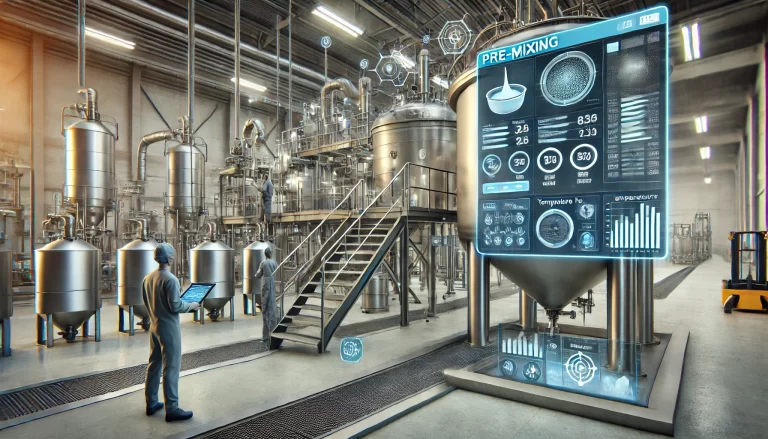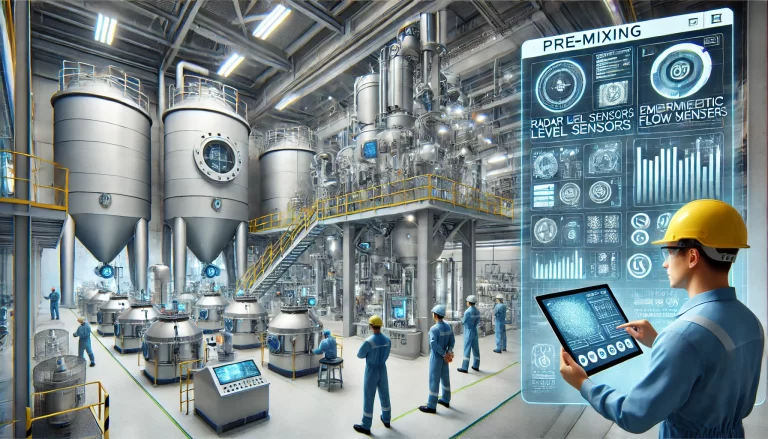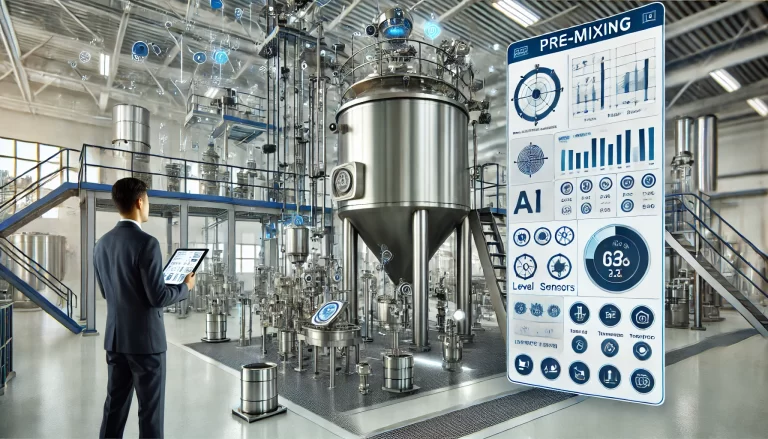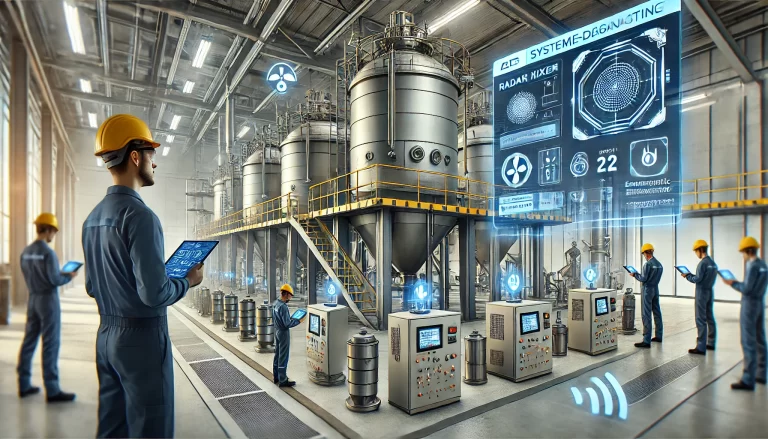Pre-mixing equipment plays a critical role in various industries such as chemicals, pharmaceuticals, food production, and construction materials. Its core purpose is to ensure precise mixing and control, guaranteeing uniform material blending, stable reactions, and consistent product quality. Given the diverse nature of materials across different industries, pre-mixing processes often require custom solutions. However, traditional measurement and control methods struggle to meet the demands of modern smart manufacturing.
This article explores how to optimize instrument selection through multidisciplinary approaches, including physics, chemistry, and fluid dynamics, to improve mixing efficiency, reduce energy consumption, and achieve intelligent system upgrades.
1. Key Measurement and Control Parameters in Pre-Mixing Processes
Several variables affect the effectiveness of material mixing and the quality of the final product. Understanding the significance of each parameter and its impact on process outcomes is essential when selecting instruments.
1.1 Liquid Level Measurement: Dynamic Adjustment and Nonlinear Compensation
Accurate liquid level measurement is fundamental to precise material supply control. However, several challenges arise during operations:
- Foam Interference: The formation of foam during mixing can attenuate radar echoes, reducing measurement accuracy.
- Temperature and Density Variations: Hydrostatic level sensors are influenced by changes in material density, requiring real-time compensation.
- Viscous Material Build-Up: For highly viscous liquids such as polymer slurries, conventional measurement methods may fail due to material adhering to sensor surfaces.
Instrument Selection Strategy:
- Radar Level Sensors (FMCW or TDR): Suitable for high-temperature, high-pressure, and viscous liquids. These sensors can penetrate foam but require dielectric constant calibration.
- Dual-Mode Measurement (Radar + Hydrostatic): Ideal for high-precision requirements where radar handles non-contact measurement and hydrostatic sensors compensate for density variations.
- Tuning Fork Level Switches: Recommended for emulsions or processes with significant foam.

1.2 Flow Measurement: Accurate Dosing and Fluid Property Adaptation
Flow measurement accuracy directly influences the precision of ingredient ratios. The varying properties of different fluids, such as viscosity, density, and shear-thinning behavior, present unique challenges:
- Non-Newtonian Fluids: Fluids like coatings, latex solutions, and food slurries exhibit viscosity changes with shear rate.
- Suspensions: Ultrasonic flow meters may encounter signal interference from solid particles.
- Low-Flow High-Precision Needs: Applications like pharmaceutical production and fine chemical processing demand high accuracy at low flow rates.
Instrument Selection Strategy:
- Mass Flow Meters: These directly measure mass flow and density, providing high accuracy but at a higher cost.
- Electromagnetic Flow Meters: Suitable for conductive liquids, with low maintenance requirements. However, they are ineffective for non-conductive fluids.
- Ultrasonic Flow Meters (Transit Time or Doppler): Ideal for large-diameter pipelines and non-contact measurement, particularly in hygienic applications such as food and pharmaceuticals.
For viscous liquids, combining mass flow meters with temperature compensation ensures that viscosity changes do not compromise measurement accuracy.

1.3 Temperature Measurement: Dynamic Control of Heat Transfer and Mixing Efficiency
Temperature significantly affects reaction rates, solubility, and viscosity. Precise temperature control is critical but faces challenges such as:
- Temperature Gradients: Uneven temperature distribution within the mixing tank can impact process stability.
- Thermal Inertia: Sensors may lag during rapid heating or cooling, leading to control inaccuracies.
Instrument Selection Strategy:
- Platinum Resistance Thermometers (RTD): Suitable for medium to low-temperature applications requiring high precision, such as in pharmaceutical and food industries.
- Thermocouples (TC): Preferred for high-temperature environments due to their fast response but slightly lower long-term stability.
- Infrared Thermometers: Ideal for non-contact surface temperature monitoring but sensitive to environmental factors.
The optimal solution involves combining embedded temperature sensors with infrared measurement to dynamically monitor tank temperature distribution and enhance control accuracy.
1.4 Pressure Measurement: Ensuring Process Safety in Closed Systems
In sealed mixing tanks, pressure monitoring plays a vital role in managing gas dissolution, evaporation, and system integrity. High-shear mixing can cause local pressure fluctuations due to bubble dissolution.
Instrument Selection Strategy:
- Diffused Silicon Pressure Transmitters: Reliable for general pressure measurement with high stability.
- Ceramic Pressure Sensors: Resistant to corrosive media, suitable for harsh environments.
- Differential Pressure Sensors: Ideal for vacuum or low-pressure systems requiring precise control.
Incorporating intelligent pressure compensation algorithms can correct pressure fluctuations caused by temperature changes, enhancing system stability.
1.5 Torque Measurement: Real-Time Monitoring of Mixing Conditions
Torque measurement provides direct insights into material viscosity changes, enabling dynamic adjustments to mixing speed and optimizing energy consumption. This is particularly important in high-shear mixing and viscous fluid blending processes.
Instrument Selection Strategy:
- Strain Gauge Torque Sensors: Suitable for high-precision applications in industries like pharmaceuticals and cosmetics.
- Magnetic Inductive Torque Sensors: Effective for dynamic measurement, ideal for high-shear mixing operations.
Integrating AI-driven viscosity prediction models can enhance torque-speed optimization, improving mixing uniformity and reducing energy consumption.

2. Intelligent Trends and Future Developments
The evolution of measurement and control technologies is driving smarter and more efficient pre-mixing systems. Key trends include:
- Smart Sensors with Self-Diagnostics: Multi-sensor fusion technology enables error self-calibration, improving measurement accuracy.
- Wireless Sensor Networks (WSN): Reducing cabling costs and enhancing remote monitoring capabilities.
- AI and Big Data Analytics: Machine learning optimizes mixing parameters through adaptive adjustments.
- Digital Twin Technology: Virtual models simulate equipment performance, predicting maintenance needs and improving reliability.
In the future, pre-mixing instruments will transcend their traditional measurement roles to become integral components of intelligent control systems, enhancing productivity while reducing costs.

Conclusion
Selecting the right instruments for pre-mixing equipment is not just about achieving measurement precision. It also requires alignment with process needs, smart manufacturing trends, and maintenance considerations. By leveraging precise control, intelligent optimization, and data-driven insights, manufacturers can significantly boost mixing efficiency, reduce energy consumption, and strengthen process stability, paving the way for smart industry advancements.
